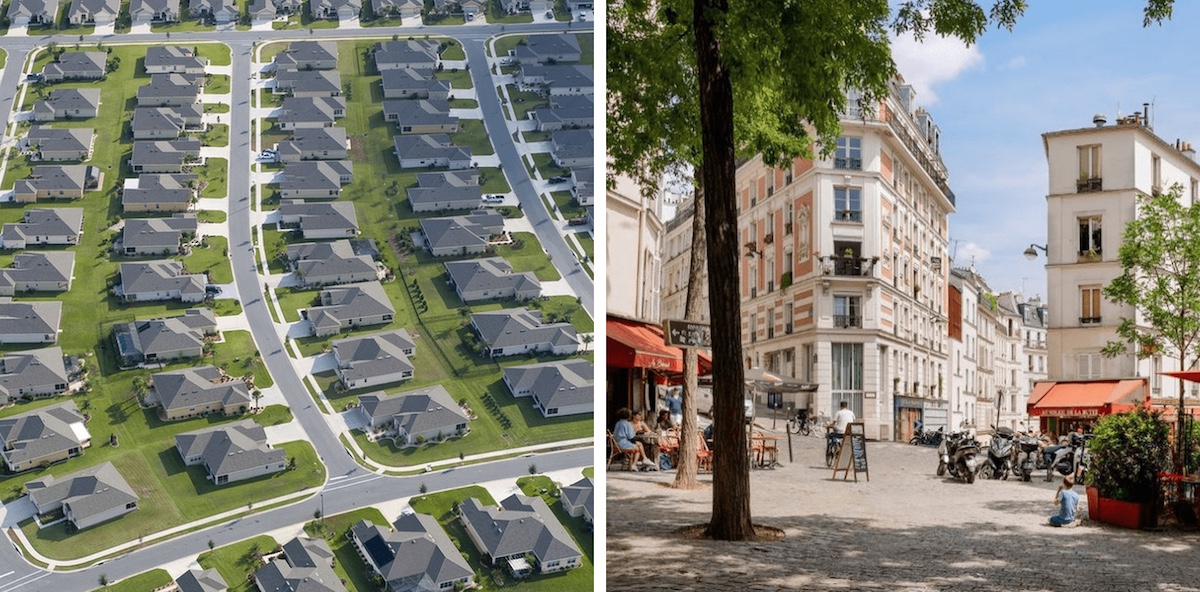Why Do American Cities Feel Lifeless?
June 19, 2024

Think of any city you visit as a tourist or any neighborhood preserved for its historic value. Chances are, you’ll find yourself surrounded by grand period buildings, a Main street of old masonry dwellings with shops on the ground floor, or tree-lined streets of row houses and brownstones.
These places simply feel more vibrant. People make pilgrimages to see them in Europe each year by the millions — and yet, in American society, we have stopped building these places to enjoy in our daily lives.
Why did we end up with vast, sprawling suburbs and copy-paste downtown glass towers?
Well, American cities used to be much more like European ones. It has to do with something called “the missing middle”…
Neutral project is actively trying to transform America’s urban fabric by building back the “missing middle”.
We’re bringing back manual craftsmanship to modern construction: sustainable materials, mass timber, brick facades by local masons… You too can invest directly into reviving American communities.
-min.png)
America Once Looked Very Different…
-min.png)
At the end of the 19th century, American cities were similar to European ones. They had much smaller physical footprints than today (total area compared to population size).
Most buildings were between 4-10 stories tall surrounded by access to public transportation and proximity to local amenities: grocery stores, theaters, museums, restaurants, bars, and cafés.
Most city dwellers in the lower to middle-income brackets lived in dense urban environments within a practical distance of their workplace. The wealthier classes were slightly further out but near enough to commute via elegant streetcars.
This is no longer the case due to the near-extinction of the “missing middle”…
Missing Middle Housing
-min.png)
“Missing middle housing” simply means medium-density housing options that bridge the gap between single-family homes and high-rise apartments.
-min.png)
Today, in America, there is almost nothing in between. You have endless sprawls of suburban homes where people live, completely separate from where they work or socialize. Or, right in the center of town, people live in high-rise tower blocks.
Middle housing typology is what makes cities feel dense and vibrant. Walkable neighborhoods of Europe, especially the old towns, have plenty of it — and it’s a simple yet powerful way to revitalize our urban landscape.
-min.png)
Before the late 1940s, cities across the United States were adorned with beautiful “missing middle” homes, like two-flats in Chicago, brownstone rowhouses in Brooklyn, triple-deckers in Boston, and bungalow courts in California.
Where did America’s Missing Middle go?
Well, we stopped building it — or in some cases, demolished it.
It went extinct over the last 70 years. After WWII, most US cities prioritized suburban sprawl over increasing population density in urban cores. This shift was tied to notions of the “American dream” promoted in popular culture: a big suburban house, a car, a job in the city. At the time, the urban living conditions without the modern conveniences like universal plumbing, heating and air conditioning were not nearly as comfortable as the promise of a stand alone house with a green lawn or a large shopping mall with infinite free parking.
Mass swathes of cities, like Kansas City, Milwaukee, and Minneapolis, were gradually demolished to accommodate more lanes of traffic, more parking, and commercial high-rises. This process was initially driven by a utopian vision of the freedom that the car-oriented society promised. Over time, the streetscape became unrecognisable, the memories of the cities of the past faded, and new generations accepted the bland streetscape as a given.
-min.png)
Together with the rise of automobile-oriented infrastructure, urban planning in America started to prioritize single-use zoning. Planners and municipalities believed that people would prefer the convenience of modern dedicated places for work, education, shopping, rest, entertainment, and worship.
In turn, the demand for middle density dwellings in urban cores, and especially mix-use buildings declined. 521,000 people used to live in Minneapolis in 1950. The highways made it easy for people to flood the suburbs, cratering the city population to 368,000 by the 1990s. The population still hasn’t recovered — it’s around 425,000 today.
-min.png)
With fewer people living in urban cores, demand for beautiful things dwindled: a great show at an elegant theater, a delicious dinner at a neighborhood restaurant, a night walk in a lively city, a morning coffee at your local cafe. Over the past decades, we’ve started to realize just how much the car-oriented infrastructure and single-use zoning reshaped American cities, and at what cost.
So, How Do We Fix It?
-min.png)
The only way for us to revive walkable cities and revitalized downtowns is to build more mix-use neighborhoods and middle housing typology for people to live in. It sounds simplistic and obvious, but it’s a change that would breathe life, vibrancy, and beauty back into the heart of American cities.
To start, cities like Minneapolis have started to embrace zoning reforms that pave a way to middle housing and mix-use communities. For instance, they’re phasing in zoning laws to allow multi-family homes to be built in areas marked exclusively for single-family homes or commercial zones.
Zoning by itself doesn’t create new housing, developers do. Historically, development capital was highly concentrated on building suburban communities or massive urban apartment complexes and commercial buildings. With the new generation of urban dwellers seeking more walkable, diverse, and vibrant neighborhoods - there’s finally a real opportunity to create new middle housing and mix-use neighorhoods.
So what can we do?
You can support the mission and join Neutral in building the missing middle neighborhoods in America.
It’s a step towards a future where cities aren’t just functional but “alive.”
-min.png)
Neutral partnered with a popular newsletter Culture Critic on an article about the history and future of the Missing Middle housing in the U.S.